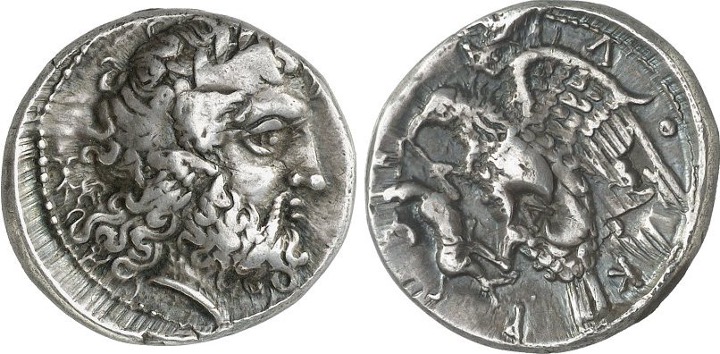399 BCE - 300 BCE | ΛΟΚΡΩΝ
Overstriking coin
SO 1408 - Locri Epizephyrii over uncertain mint.jpg
[1]
Overstruck variety
Corinth (head l.).jpg
|
|
Sale(s)Sale(s) ᵖ:
|
Auctiones, 29, 2 June 2003, 497 = Gorny & Mosch, 200, 10 Oct. 2011, 1164 = Roma Numismatics, EA, 29 Aug. 2015
|
| Private collection(s)Private collection(s) ᵖ:
|
F. James Collection
|
|
Description
| ObverseInscription or printing placed on the obverse.:
|
Head of Zeus right, wearing laurel wreath. In left field, thunderbolt. Border of dots.
|
ReverseInscription or printing placed on the reverse.:
|
ΛΟΚΡΩΝ (Greek) Eagle flying left, dead hare in talons. Border of dots.
|
Mint and issuing power
| MintIdentifies the place of manufacture or issue of a numismatic object.:
|
Locri Epizephyrii
|
Ancient regionAncient region.
|
Bruttium
|
Modern countryModern country: Italy
|
AuthorityIdentifies the issuing power. The authority can be "pretended" when the name or the portrait of X is on the coin but he/she was not the issuing power. It can also be "uncertain" when there is no mention of X on the coin but he/she was the issuing power according to the historical sources:
|
|
Chronology
| FromIdentifies the initial date in a range assigned in a numismatic context. 399 BCE toIdentifies the final date in a range assigned in a numismatic context.. 300 BCE
|
Classical 480-323 BC  periodTime period of the numismatic object. periodTime period of the numismatic object.
|
Physical description
MetalThe physical material (usually metal) from which an object is made.: Silver 
|
WeightWeight of the numismatic object (in grams). in grams: 7.667.66 g <br />7,660 mg <br />
|
DenominationTerm indicating the value of a numismatic object. Examples: tetradrachm, chalkous, denarius.: nomos
|
|
|
|
StandardStandard.: Achaian
|
References
Description
| ObverseInscription or printing placed on the obverse.:
|
Pegasus (visible on obverse: traces of pegasos' body)
|
ReverseInscription or printing placed on the reverse.:
|
Head of Athena (visible on reverse: tail and some of back of helmet, A behind, and neck termination)
|
Mint and issuing power
| MintIdentifies the place of manufacture or issue of a numismatic object. ᵖ:
|
Corinth
|
Ancient regionAncient region. ᵖ
|
Peloponnesus
|
Modern countryModern country: Greece
|
AuthorityIdentifies the authority in whose name (explicitly or implicitly) a numismatic object was issued. ᵖ:
|
|
Chronology
| FromIdentifies the initial date in a range assigned in a numismatic context. 410 BCE toIdentifies the final date in a range assigned in a numismatic context.. 350 BCE
|
Classical 480-323 BC  periodTime period of the numismatic object. periodTime period of the numismatic object.
|
Physical description
| DenominationTerm indicating the value of a numismatic object. Examples: tetradrachm, chalkous, denarius. ᵖ:
|
stater 
|
|
|
References
| Frequency of overstrikesFrequency of overstrikes:
|
rare and concentrated
|
Level of confidenceLevel of confidence of the identification:
|
sure
|
| RemarksRemarks:
|
Struck over Corinthian type Obverse: Traces of pegasos' body visible on head of Zeus. Reverse: Tail and some of back of helmet, A behind, and neck termination visible on body of eagle on reverse (identification: David MacDonald)
|
References
- ^ Troxell, Hyla A. (1975), Sylloge Nummorum Graecorum ANS 3. The Collection of the American Numismatic Society. Sicily 3 (Bruttium-Sicily I: Abacaenum-Eryx), New-York, pl. 38.
- ^ Rutter N. Keith et alii (eds.) (2001), Historia Numorum Italy, London, xvi, 223 p., 43 pl.
- ^ Hoover, Oliver D. (2018), The Handbook of Greek Coinage Series, Volume 1. Handbook of Coins of Italy and Magna Graecia, Sixth to First Centuries BC., Lancaster-London, 2018, lxi, 527 pages, 23 cm
- ^ Calciati, Romolo (1990), Pegasi, Mortara, Edizioni I.P..


